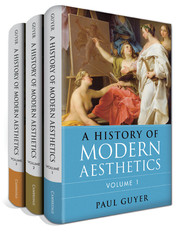Book contents
- Volume 1 The Eighteenth Century
- Volume 2 The Nineteenth Century
- Volume 3 The Twentieth Century
- Frontmatter
- Contents
- Acknowledgments
- Introduction
- Part One German Aesthetics in the Twentieth Century
- Part Two Aesthetics in Britain until World War II
- Part Three American Aesthetics in the First Half of the Twentieth Century
- 6 Santayana
- 7 The American Reception of Expression Theory I
- 8 Dewey
- 9 The American Reception of Expression Theory II
- 10 After Dewey and Cassirer
- Part Four Wittgenstein and After
- Bibliography
- References
10 - After Dewey and Cassirer
from Part Three - American Aesthetics in the First Half of the Twentieth Century
Published online by Cambridge University Press: 05 June 2015
- Volume 1 The Eighteenth Century
- Volume 2 The Nineteenth Century
- Volume 3 The Twentieth Century
- Frontmatter
- Contents
- Acknowledgments
- Introduction
- Part One German Aesthetics in the Twentieth Century
- Part Two Aesthetics in Britain until World War II
- Part Three American Aesthetics in the First Half of the Twentieth Century
- 6 Santayana
- 7 The American Reception of Expression Theory I
- 8 Dewey
- 9 The American Reception of Expression Theory II
- 10 After Dewey and Cassirer
- Part Four Wittgenstein and After
- Bibliography
- References
Summary
There were three great influences on aesthetic theory in the English-speaking world in the 1950s and the next several decades. Dewey’s conception of aesthetic experience as consummatory experience and the theory of art as symbolism associated in the previous section with Cassirer and Langer but also explored by other thinkers from Charles Sanders Pierce to Charles S. Morris were both especially influential in the United States; the influence of the later work of Ludwig Wittgenstein was pronounced in both the United States and Great Britain, to the point of largely effacing the previous traditions in aesthetics. The influence of Wittgenstein will be the subject of the next part; the last chapter of this part will discuss first the influence of the Deweyan conception of aesthetic experience, accompanied with some continuing influence from Santayana, and then the influence of the conception of art as a form of symbolism. Of course, none of the philosophers interesting enough to be discussed here was an epigone whose thought simply restated that of a single master.
Gotshalk
The first of the three philosophers to be discussed here, Dilman Walter Gotshalk (1901–73), should not be too closely associated with Dewey; in some ways, the structure of his theory more closely resembles that of Santayana, whom he cited more often in his chief work in aesthetics Art and the Social Order (1947) than any other philosopher besides Kant and Croce, although he cites the latter chiefly to criticize him. But his explication of aesthetic experience as paying special attention to perception but involving all of our cognitive capacities in “one of the great immediate and self-rewarding goods available to human energy” while also fulfilling numerous external and social aims is hardly alien to the spirit of Dewey’s aesthetics. The style of Gotshalk’s work is certainly different from that of Dewey’s: Where Dewey delighted in rejecting dualisms of any sort, Gotshalk was a more traditional academic philosopher who multiplied distinctions whenever he could.
- Type
- Chapter
- Information
- A History of Modern Aesthetics , pp. 367 - 428Publisher: Cambridge University PressPrint publication year: 2014



